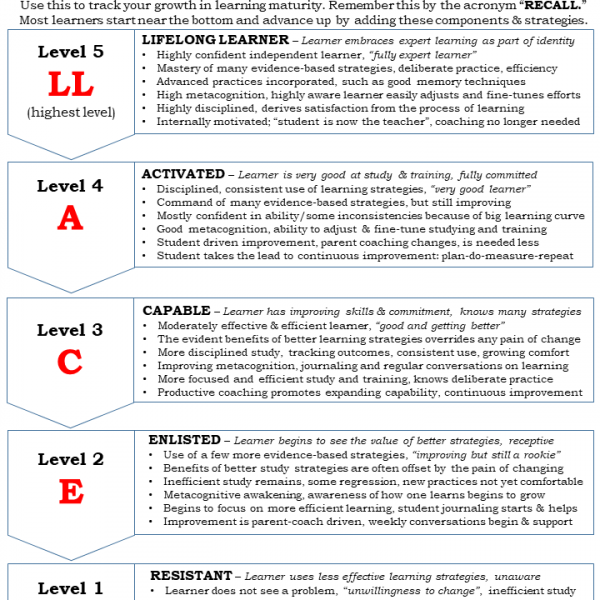
Desirable Difficulties can Transform Your Learning and Teaching

Reading time: 11 minutes
Summary
This article explains one of the most powerful learning strategies you can use. The concept of “Desirable Difficulties” is something that needs to be understood by both the student and the teacher. It has fundamental implications on how you should organize your study efforts and instructional plans. Once you know how to do this, it will open the door to optimal learning and knowing how to organize your studies so you can learn much more rapidly.
When you incorporate this into your teaching, your lessons will be designed for better learning and recall.
There is a considerable upside to knowing this. Students who don’t understand desirable difficulties engage in less effective learning practices, and waste considerable time studying.
Research reveals expert performers frequently deploy desirable difficulties when they train. If you want to get much better at something you will need to understand the principles behind it and know how to deploy it. People who don’t use it to train, will find they plateau at some point and don’t get better. Teachers who don’t incorporate it into their instructional planning will waste considerable class time with redundant review of information.
This article explains desirable difficulties (DD for short) and provides you with five important concepts you should coach your child to use when studying and training. There are discussion questions you can use at the end.
Definition
First, let’s define it:
| A desirable difficulty is a learning task that requires a considerable but desirable amount of effort, thereby improving long-term performance |
It’s the opposite of getting “comfortable” with your training, making it easy and safe, trying to minimize mistakes. It means making things a little more challenging, pushing yourself and being willing to make more mistakes so you can learn from them. It also means frequently testing yourself to find the gaps where you uncover what you don’t know when you thought you knew it.
You plan your study and training efforts so that you make them a little more difficult and then keep adjusting them so that you stay in this slight difficulty zone. This is a method you planfully incorporate into your study and training sessions. Make it a habit.
DD comes from two well-known researchers, the husband and wife team of Elizabeth and Robert Bjork, who have extensively researched learning and provide us with useful insights on this powerful learning and studying strategy. What did they conclude about incorporating “desirable difficulties” into your studies and practicing?
First “desirable difficulties” is a relatively new way of thinking to help you learn. Note they are not talking about those distracting difficulties that like those that harm learning through interruptions, or things in the room that compete with attention.
Desirable difficulties has many benefits including enhancing longer term retention. This means not only do you need to discuss this with your child, but you need to implement it as a keystone practice that underscores all study, training, and teaching.
So, what are these conditions of learning that you want to incorporate into your teaching and encourage your student to use while studying? What do you need to do to have more durable and flexible learning?
Some Examples of Desirable Difficulties
To help you understand this, here are examples of desirable difficulties:
- The student varies the conditions of learning, rather than keeping them constant and predictable. A learning activity is done for a short period of time until it begins to get easier, then it is changed or modified.
- As a teacher, you interleave your instruction on separate topics rather than grouping instruction by topic (presenting lots of information on one topic is called blocking).
- When studying a particular topic, you space your sessions out over multiple days rather than sitting down and massing all your study sessions in one day.
- As a teacher, you use frequent tests and closed book exercises that require recall, rather than adding more presentations and study events. It’s harder – but better.
- A music student starts by playing scales for 15 minutes, then moves to practicing a familiar work for a while, then moves to a new difficult piece she is trying to learn. She avoids doing the same thing for too long.
- A weightlifter sets the goal of adding 2 ½ pounds more weight per week on her dead lift exercise to build up her leg muscles. She will do this for the next 20 weeks. In a given day, if she is feeling strong, she may add a little more weight for that day. She may vary sets and repetitions so that she always feels she is pushing that muscle group.
Does this make learning less fun? (yes – learning can be fun!) In the short term yes, probably. But it can make the training more challenging and interesting. The mind and the body will adjust to this after a while, and it will become a normal activity. And the better results lead to higher personal motivation.
But the student needs to separate activities by the intended purpose. If that book you are reading is summer fun escapism fiction, you don’t need DD. If you are reading the book because you are trying to learn a new language, then you do. If you are learning a song for next week’s recital, which you don’t intend to do again, you don’t need DD. If you are learning a new song that you want to remember for a long time, then you should apply DD.
Training for short term performance is a different process from long term retention. If your goal is to build a base of knowledge that can be retrieved and used over longer periods of time, then you need to teach your child to study differently and you need to incorporate DD into homeschool teaching.
Bjork and Bjork are telling us to take a more proactive approach to our studying and learning. What this means is that if you don’t undertake the effort to make learning a little more challenging, then you risk not experiencing optimal learning.
They remind us that this approach may encounter personal resistance. It’s initially harder, and at first it may seem that our performance is worse than easier practice. This risks that the learner will be tempted to abandon desirable difficulties because they don’t seem to be working very well.
“Optimizing learning and instruction often requires going against one’s intuition, deviating from standard instructional practices, and managing one’s own learning activities in new ways.”
“(The) trial and errors of everyday learning do not seem to result in the development of an accurate mental model of the self as learner.”
This is one of the reasons that DD benefits from having the parent as a coach who can help the learner stay motivated until better results become evident. We have the natural tendency to drift back to the easiest path.
Five Key Ideas
Here’s what Bjork and Bjork conclude you need to know about effective study techniques.
1. The student must take a more active role in learning. This is a theme that we emphasize throughout our Pa 10 and Pa 100 courses. When students take passive approaches to learning – for example, sitting down to study without a plan such as beginning the reading a chapter with no end in mind other than finishing it, we know this is not as effective as a more conscious effort to make the study more difficult.
The finding that better planning assists better learning is not surprising, for this is true with most endeavors. But planning to make studies a little more difficult does improve learning, and the fact is most students do not recognize the importance of actively generating good study plans to push themselves to learn more.
Why is this skipped over? Perhaps this is too obvious to do, or that it is inconvenient because it adds a little more time to do it. Maybe planning is avoided because there is a natural bias to “just get started.” After all, we do live in a “Just do it” culture.
You can coach your child to do better study planning in your weekly SPR – study planning and review meetings. There is more information on this later in the Pa 10 course.
The trained and skillful learner will know the benefits of introducing “desirable difficulties” into their own study activities. But this means the student must take a moment to consciously make decisions on what those series of activities need to be that will keep their brain challenged. This means two things:
1) the student first needs a command of the available strategies, and then
2) they need self-awareness as to how they learn best. This second point refers to the “metacognition” that we cover in another article in parent resources.
2. Deploying an active process of learning where new information is connected to and mapped to things we already know. Their research also found that a more passive study efforts, such as rereading material several times until it seems to “stick” is less effective in terms of longer-term retention, as well as being an inefficient use of study time.
This may come from a misunderstanding of how the brain learns. The Bjorks suggest we must transform how we understand the process of learning:
“Above all, try to rid yourself of the idea that memory works like a tape or video recorder and that re-exposing yourself to the same material over and over again will somehow write it into your memory.”
It doesn’t. Inform your child that memory doesn’t work like a video recorder. Study and practice that forces you to retrieve information is better. This activates the brain networks that will allow you to retrieve information in the future when you need it.
3. There are illusions of learning that can tempt us into less effective strategies. They found that it is common for students to think they are learning, when in fact they are not. The two Bjorks state:
“The basic problem learners confront is that we can easily be misled as to whether we are learning effectively and have or have not achieved a level of learning and comprehension.”
Again, take rereading a chapter for example. They found, when rereading a chapter or your notes, that prior exposures create a sense of familiarity that can be easily confused with understanding. When this happens, the student is confusing recognizing something with thinking they have memorized the material. Only later will they discover, perhaps during a test, that they cannot retrieve it.
What’s the solution to this problem? Engage in frequent self-testing so that you learn what you don’t know.
4. Retrieval Practice – much more than re-studying – is more effective. This is a better learning strategy. Learn to modify your memory by taking the information you are learning and trying to retrieve it often – you will more likely to be recall it in the future and in different contexts. For example, close the chapter you are reading and try to recall all the key facts and ideas. At first this is harder, but it gets easier the more you do it.
What this means is setting learning strategies where the student balances the time spent on the input side with time spent on the output side, such as summarizing what you read from memory by getting together with friends and asking each other questions.
5. Activities that involve testing yourself will make your learning both more durable and flexible. That is, use study strategies that require you to retrieve or generate information, rather than just representing information to yourself.
It is commonly held belief that the function of testing is assessment, which is only partially correct. In recent years the role of testing as a learning tool by itself has received greater emphasis. (see Roediger & Karpicke, 2006). Testing can be of any kind, including self-tests informally developed by the student, trying to list all the main ideas on a white board, and trying to answer all the questions posed at the end of each chapter.
The idea is to force yourself to frequently recall information. Information and facts that are retrieved in response to any kind of test not only become more retrievable in the future than they would have been without a test, but they even become more retrievable than if they had been restudied multiple times.
Change your thinking about tests and treat them primarily as learning tools. Consider them useful for not only uncovering what you don’t know that you thought you did, but a way to practice retrieving information so you can remember and recall in the future.
In summary, you will want to have frequent conversations on learning how to manage your learning activities. In an ever more complex and rapidly changing world where learning on one’s own is becoming ever more important, desirable difficulties becomes the ultimate tool to success.
Good Conversation Starters
Here’s some good questions to talk about that help you explore desirable difficulties.
- Weight Lifter A never increases the weight he uses to bench press. Weight Lifter B adds a little more weight to the bar every two weeks. Who will get stronger faster? Why?
- Closed book exams are a more effective tool for learning than open book exams. Why? This forces the student to do which learning strategy?
- Why is it OK for you to get “comfortable” when reading a fun fiction book, but not when you are trying to learn something you want to remember for a long time?
- In this article, the idea of setting learning strategies where the student balances the time spent on the input side with time spent on the output side was introduced. In terms of your study practices, what does this mean?
- Identify a subject you are studying where you now allow yourself to get too comfortable. What could you do differently to add desirable difficulties?
Source: “Making Things Hard on Yourself, But in a Good Way: Creating Desirable Difficulties to Enhance Learning” – Elizabeth Ligon Bjork and Robert A. Bjork University of California, Los Angeles






